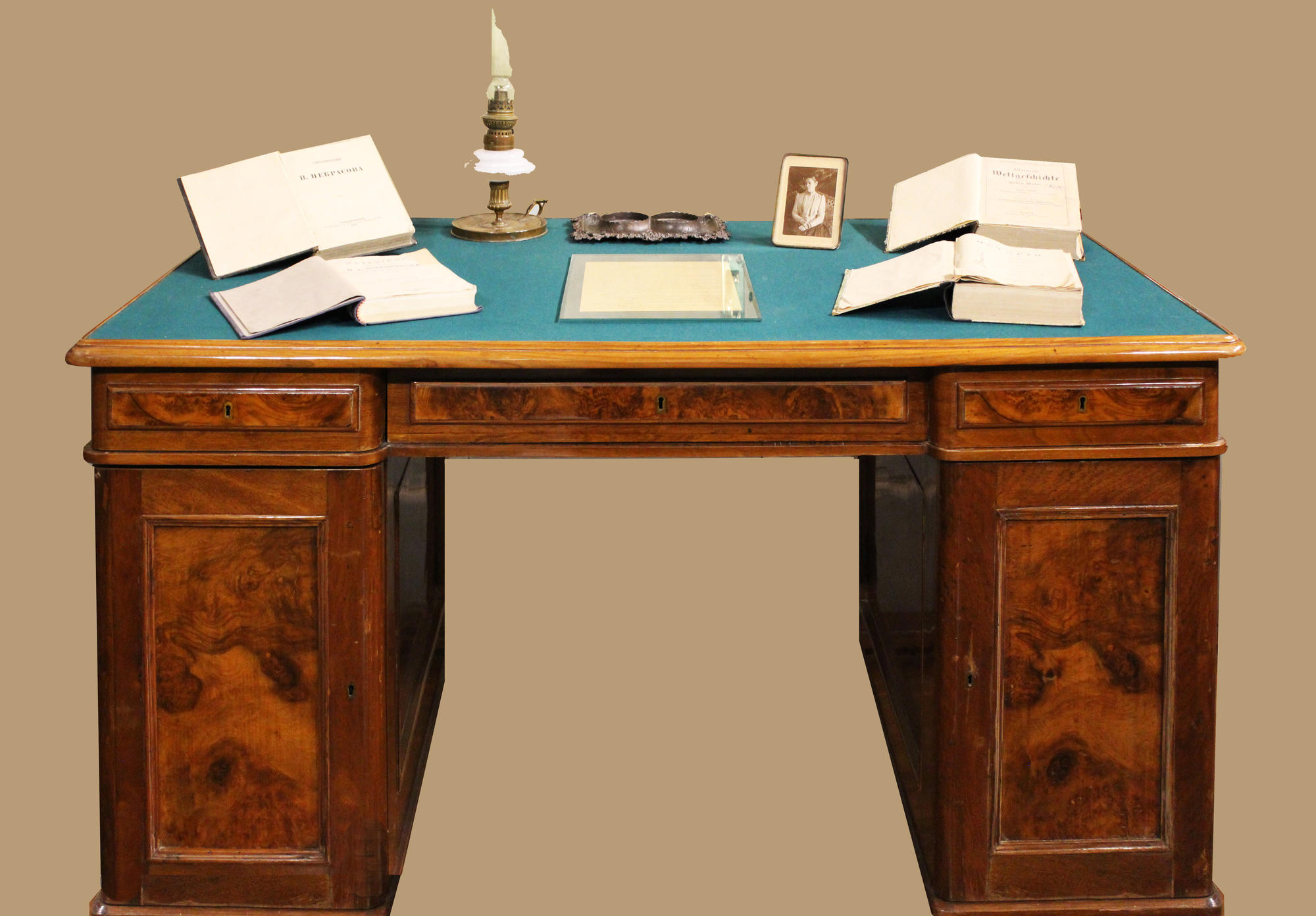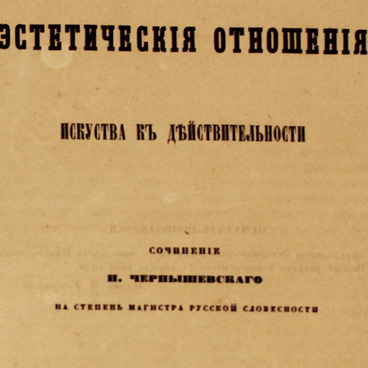The final section of the Worthy Son of Motherland exposition includes a writing desk that Nikolai Chernyshevsky used in Astrakhan and Saratov in the last years of his life.
Like the double pedestal desk in St. Petersburg, this piece displays classic proportions although it is smaller in size. The desk is veneered with chestnut plywood; it has three top drawers and several drawers behind the doors in the pedestals. The under desk drawers are decorated with chestnut panels and an astragal separates them from the pedestals. The corners of the under desk unit and pedestals are rounded and the top has oval edges.
After the sudden death of Nikolai Chernyshevsky in 1889, his widow, Olga Sokratovna, made an inscription of the date of his death inside one of the drawers: “Desk of the late Nikolai Gavrilovich Chernyshevsky, from his widow Olga Chernyshevskaya. Oct. 17, 1889. She gave the desk to her nephew A. K. Bukovsky. In 1936, the desk was found in the accounting department of the Council of Trade Unions in the town of Engels — identified by the memorial inscription in the drawer.
As remembered by his secretary, Konstantin Fedorov, Chernyshevsky secluded himself from society in Saratov, just as he had in Astrakhan: “He was an indefatigable man of desk work, his life was only about his books; he would spend days and nights sitting over his translation of numerous volumes of [Georg Weber”s] Basic World History, biographical materials on the life of Dobrolyubov, and other works”.
At this very desk, Chernyshevsky began working on his last ever article, Thoughts about the Future of Saratov, which he intended to publish in a Saratov newspaper. He believed social and political writing had an important public mission — in his opinion, it was to establish a progressive belief system in the Russian society.
The article begins with Chernyshevsky’s memories of the Volga River as he saw it as a child and later, a teacher in a Saratov secondary school. Above all, the writer associated the future of his home town with saving the river from shallowing — at that time, a rare newspaper issue came out without an article on the topic. The beginning of Thoughts about the Future of Saratov was found in the archive by Chernyshevsky’s younger son Mikhail
Like the double pedestal desk in St. Petersburg, this piece displays classic proportions although it is smaller in size. The desk is veneered with chestnut plywood; it has three top drawers and several drawers behind the doors in the pedestals. The under desk drawers are decorated with chestnut panels and an astragal separates them from the pedestals. The corners of the under desk unit and pedestals are rounded and the top has oval edges.
After the sudden death of Nikolai Chernyshevsky in 1889, his widow, Olga Sokratovna, made an inscription of the date of his death inside one of the drawers: “Desk of the late Nikolai Gavrilovich Chernyshevsky, from his widow Olga Chernyshevskaya. Oct. 17, 1889. She gave the desk to her nephew A. K. Bukovsky. In 1936, the desk was found in the accounting department of the Council of Trade Unions in the town of Engels — identified by the memorial inscription in the drawer.
As remembered by his secretary, Konstantin Fedorov, Chernyshevsky secluded himself from society in Saratov, just as he had in Astrakhan: “He was an indefatigable man of desk work, his life was only about his books; he would spend days and nights sitting over his translation of numerous volumes of [Georg Weber”s] Basic World History, biographical materials on the life of Dobrolyubov, and other works”.
At this very desk, Chernyshevsky began working on his last ever article, Thoughts about the Future of Saratov, which he intended to publish in a Saratov newspaper. He believed social and political writing had an important public mission — in his opinion, it was to establish a progressive belief system in the Russian society.
The article begins with Chernyshevsky’s memories of the Volga River as he saw it as a child and later, a teacher in a Saratov secondary school. Above all, the writer associated the future of his home town with saving the river from shallowing — at that time, a rare newspaper issue came out without an article on the topic. The beginning of Thoughts about the Future of Saratov was found in the archive by Chernyshevsky’s younger son Mikhail








